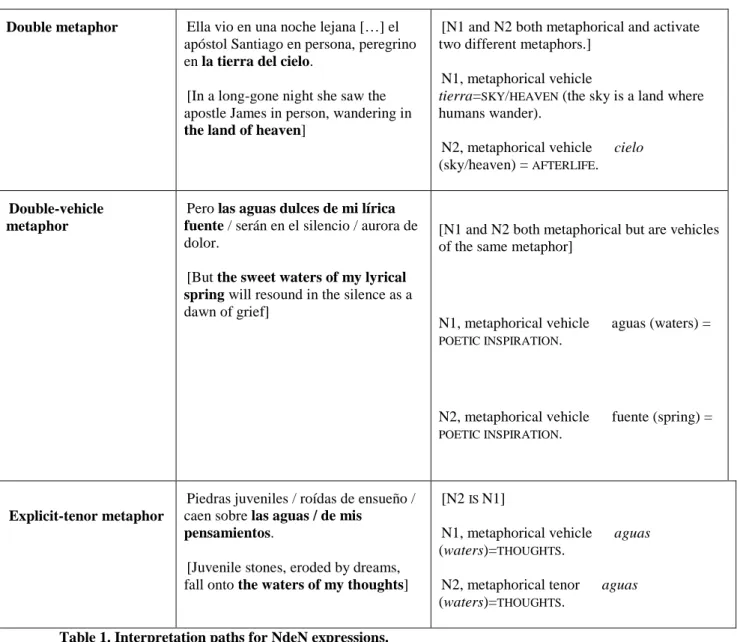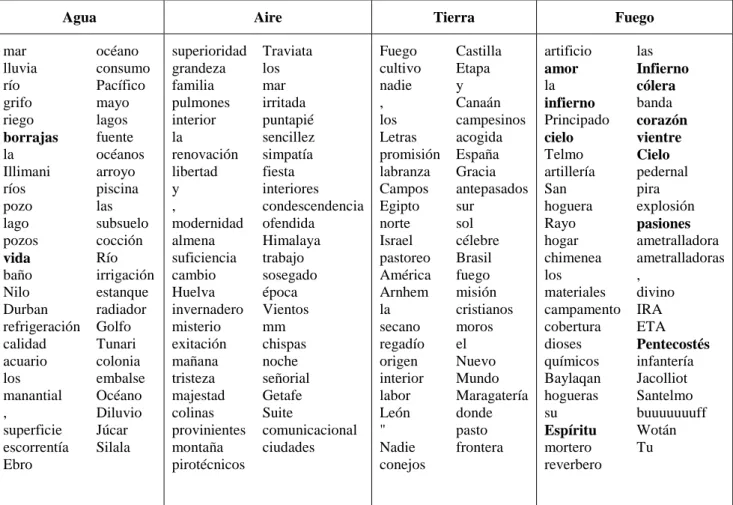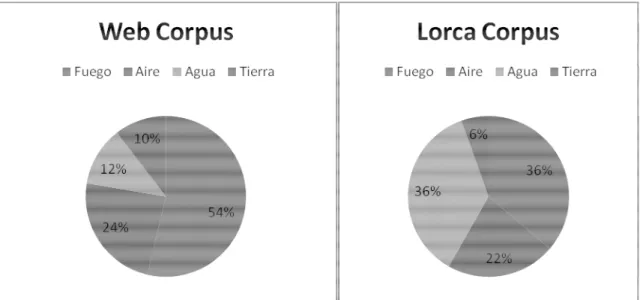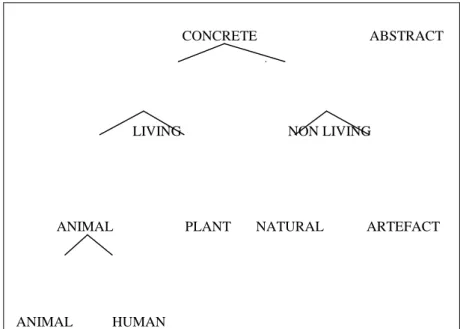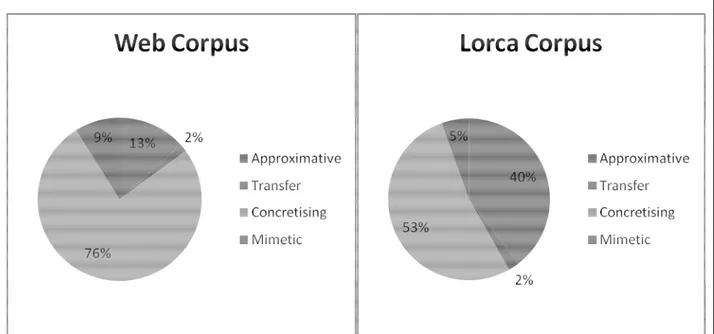What is creative about a creative figurative expression? Comparing distribution of metaphors in a literary and a non-literary corpus*
Sara Piccioni, University of Bologna (Italy) [email protected]
1. Background
Creativity of literary figurative expressions is often explained in terms of their “richness” or polyvalence, i.e. their capacity to give rise to multiple simultaneous interpretations. Such richness is variously defined in congnitively-inspired accounts, in terms of the number of predicates imported from one domain to the other (Gentner 1982) and of conceptual complexity (Steen 1994).
Little attention has been paid to the linguistic features that contribute to the richness of literary metaphor. Hrushovski (1984) illustrates the phenomenon of etymologisation, whereby a word is used in relation to both its present and its etymological meaning. Heywood, Semino and Short (2002) and Steen (1999) provide further examples of how the interplay of literal and metaphorical senses of a given word/structure may account for the richness of literary metaphorical expressions. path
This paper argues that metaphorical richness can be given a unified account in terms of different degrees of meaning encoding, i.e. the degree to which an expression has a ready-made meaning available to it. In particular, it claims that the distinction between conventional and creative expressions corresponds to the distinction between fully codified and undercodified expressions. Conventional figurative expressions are fully codified and are easily and univocally decoded. Creative expressions, on the other hand, are those that lack codified meanings and are, therefore, only accessed via a conscious act of interpretation involving linguistic and textual clues as well as world knowledge. The result of such a conscious and subjective act of interpretation is inherently richer.
Meaning encoding affects different linguistic levels. On a lexical level, for example, a metaphorical expression is fully-encoded if it refers to a lexicalised sense of a word (e.g., mouse as used in “Using a mouse is very convenient -- but some might prefer the keyboard”). At the syntactic level, metaphorically used constructions are decoded in recurrent ways, as is the case for metaphors based on the “NOUN of NOUN” (NdeN hereafter) structure that are interpreted as N2 IS N1 (e.g. the journey of life interpreted as life is a journey): standard decoding routines are part of the encoded meaning of the structure.
Whether an expression has a stable meaning can be assessed based on the frequency of the expression itself or of one its linguistic features. So, for example, the high frequency with which the word mouse is used to refer to “a small device which you move across a surface in order to move a pointer on your computer screen” (Cambridge Learner’s Dictionary) makes it a stable/encoded meaning of the metaphorical expression; as a result, the metaphorically used word produces a single, monovalent interpretation.
In the light of this, defining creativity implies defining what is not encoded as a stable meaning of a given expression. It is here hypothesised that “underencoding” of creative expressions
can be characterised along three quantitatively observable parameters. First, at the syntactic level, the structure at study gives rise to a limited set of possible interpretations, here defined “interpretation paths”: the most frequent of these constitute an encoded meaning of the structure; the others are creative exploitations and force “alternative” interpretations. Second, lexically encoded meanings correspond to lexicalised meanings. Third, semantic distance of vehicles and tenors of an expression is considered indicative of usual, “encoded” ways of combining concepts.
The validity of these three parameters is tested against data by comparing figurative realisations of a single syntactic structure (“NOUN de (=of) NOUN”, NdeN hereafter) in Spanish in a literary and a non-literary corpus. Results show that the syntactic structure has a preferred figurative realisation. The high recurrence of a single category of uses suggests that speakers are regularly exposed to figurative expressions of this kind and can therefore access (at least partially) automatic decoding options. Less frequent uses, on the other hand, do not carry codified meanings and only acquire meaning in their context through a conscious act of interpretation.
2. Method and data
The analysis considers figurative NdeN expressions with agua/tierra/aire/fuego as head nouns (e.g. el agua de la muerte [the water of death]). Their use is compared in two Spanish corpora: the literary corpus comprising the complete works of Spanish poet and playwright Federico García Lorca (Lorca Corpus, Piccioni 2005) and the Leeds Spanish web corpus (http://corpus.leeds.ac.uk/).
It is assumed that the selected corpora, the metaphorically productive syntactic structure (e.g., Brooke-Rose 1958, Alvar Ezquerra 1993) and the chosen head nouns (typical of the literary tradition) will allow observation of both conventional and creative uses.
Expressions extracted from the two corpora are categorised based on the three parameters mentioned above (interpretation paths, lexical conventionality, and semantic distance). Distribution of the different categories across the two corpora is then observed in order to spot uses that are typical of each corpus.
3. Data
3.1. Interpretation Paths
Interpretation paths refer to the existence of a limited set of interpretations that arise from a given syntactic structure (Brooke-Rose 1958, Goatly 1997, Prandi 2004 and 2008). The NdeN structure tends to assign its components (N1, N2 and modifiers) fixed roles as metaphorical and/or metonymic vehicles and tenors.
Figurative NdeNs in the two corpora give rise to eight different interpretation paths. Of these, two correspond to metonymic uses, three are purely metaphorical and the remaining three portray an interaction of metonymy and metaphor. Table 1 illustrates the eight interpretation paths with examples and explanations.†
†
Translations from Spanish into English provided here and elsewhere in the article are (where possible) strictly literal in order to keep the linguistic structures of the original unvaried.
Interpretation paths Examples Explanation Pure metonymy Aún quedan manchas de nieve que
resisten briosas al fuego del sol. [There are still snow patches that resist energetically to the fire of the sun]
N1, metonymic fuego [fire]= COLOUR OF THE FIRE.
N2, literal sol [sun]=SUN.
Inverted pure metonymy
Lamiendo las pobres casas / pasa cantando la acequia / con el agua tan
de plata / que parece luna llena.
[Lapping against the poor homes, flows the singing ditch, its waters of
silver resembling a full moon]
N1, literal agua [water]= WATER.
N2, metonymic plata [silver]= COLOUR OF SILVER.
Metonymy within metaphor
[“a metonimically used
entity […] embedded within a (complex) metaphorical expression”, Goossens 1995:172)]
La fuente tenía fuegos fatuos de oro. [The fountain carried will-o'-the-wisps
of gold]
N1, metaphorical vehicle fuegos fatuos (will-o'-the-wisps)= LIGHT REFLECTIONS ON THE WATER
N2, metonymic oro (gold) = COLOUR OF GOLD.
Inverted metonymy within metaphor
[adapted from Goossens’s “metonymy within metaphor”, see above]
El otoño es el fuego del gigante
incensario / Que perfuma a las almas
que desean la luz.
[Autumn is the fire of the giant
incense burner that spreads its scent
on the souls yearning for light]
[Autumn is here described as a fire that burns the atmosphere (an incense burner) and releases light/scent/heat.]
N1, metonymic fire=COLOUR/HEAT OF THE FIRE.
N2, metaphorical vehicle incense burner = autumn atmosphere.
Metaphor from metonymy
[NdeN is a metonymy in origin and is then mapped metaphorically onto an alien domain, Goossen 1995: 357)
Lolita, luz de mi vida, fuego de mis
entrañas.
[Lolita, light of my life, fire of my
entrails]
NdeN, metonymy fire of my entrails= EFFECTS OF STRONG FEELINGS ON THE BODY. ‡
NdeN, metaphorical vehicle fire of my
entrails=LOLITA.
‡ The metonymic nature of the expression can be explained in terms of its capacity to designate feelings and states of
the mind in terms of the effects that these have on the body. This is explained – among others – by Kövecses (2000) who considers the effects of emotions as part of the conceptual domain of the EMOTION itself.
Double metaphor Ella vio en una noche lejana […] el apóstol Santiago en persona, peregrino en la tierra del cielo.
[In a long-gone night she saw the apostle James in person, wandering in
the land of heaven]
[N1 and N2 both metaphorical and activate two different metaphors.]
N1, metaphorical vehicle
tierra=SKY/HEAVEN (the sky is a land where humans wander).
N2, metaphorical vehicle cielo (sky/heaven) = AFTERLIFE.
Double-vehicle metaphor
Pero las aguas dulces de mi lírica
fuente / serán en el silencio / aurora de
dolor.
[But the sweet waters of my lyrical
spring will resound in the silence as a
dawn of grief]
[N1 and N2 both metaphorical but are vehicles of the same metaphor]
N1, metaphorical vehicle aguas (waters) = POETIC INSPIRATION.
N2, metaphorical vehicle fuente (spring) = POETIC INSPIRATION.
Explicit-tenor metaphor
Piedras juveniles / roídas de ensueño / caen sobre las aguas / de mis
pensamientos.
[Juvenile stones, eroded by dreams, fall onto the waters of my thoughts]
[N2 IS N1]
N1, metaphorical vehicle aguas (waters)=THOUGHTS.
N2, metaphorical tenor aguas (waters)=THOUGHTS.
Table 1. Interpretation paths for NdeN expressions.
Analysis of the distribution of the eight interpretation paths (Figure 1 and Figure 2) shows that the different NdeN categories are in no way evenly distributed in the two corpora and point to a more flexible use of the syntactic structure in the literary corpus. In both corpora, explicit tenor metaphors (e.g., the fire of my passion) are by far the most frequent NdeN category. In the web corpus they account for 86% of all figurative uses, while –of the other categories– none accounts for more than 6% of all uses. In the Lorca corpus explicit tenor metaphors are still the most frequent category but they account for just over half of all figurative uses (58%); other categories portray a more even distribution with pure metonyms totalling almost 15% of uses. The Lorca corpus introduces three categories of figurative uses that are not found in the web corpus (inverted pure metonymy, inverted metonymy within metaphor, and double-vehicle metaphors). A further element of importance is the greater relevance that metonymic uses have in the literary corpus where pure metonyms and other forms of metaphor-metonymy interaction account for 30% of all figurative uses, while they only represent 8% of figurative NdeNs in the web corpus.
Figures 1 and 2. Incidence of each category of figurative use in the two corpora 3.2. Lexical Conventionality
Lexical conventionality refers to the degree of lexicalisation of a given sense of a word. Deignan (2005: 40-42) devises a methodology whereby the degree of lexicalisation can be assessed based on a word’s (or expression’s) frequency: historical metaphors are found when a metaphorical sense of a word has taken over the literal one, which –as a result– is extremely infrequent or rare; innovative metaphors –on the other hand– are recognised by virtue of the low frequency of their metaphorical uses.
Based on these observations, lexical conventionality of NdeN expressions is here tested against the frequency of figurative uses of the head nouns. The 20 most frequent N2s co-occurring with each of the head nouns are observed to search for those nouns that are unambiguously indicative of figurative uses. For example, in the case of fuego, collocates that designate feelings
(e.g., amor [love]) or body parts (e.g., vientre [womb]) are unambiguously associated with figurative uses (the fire of love, the fire of my womb).
Table 2 shows that the frequency of figurative use varies considerably across the four head nouns. Only two of the collocates of agua are indicative of figurative use and none of the twenty most frequent collocates of tierra can be associated with figurative uses. This contrasts with the collocates of fuego, eleven of which (more than 50%) are figurative. Collocates of aire are difficult to trace back to literal or figurative uses. This is due to the highly polysemous nature of the word where what were metaphorical uses in origin have now become stable autonomous senses. It is therefore impossible to judge whether a collocate refers to a literal or a figurative use.
Considering frequency as a measure of lexical conventionality, it is thus possible to place the head nouns at different points of a gradient of conventionality, with fuego being the most conventional figurative head followed by agua and tierra.
Agua Aire Tierra Fuego
mar lluvia río grifo riego borrajas la Illimani ríos pozo lago pozos vida baño Nilo Durban refrigeración calidad acuario los manantial , superficie escorrentía Ebro océano consumo Pacífico mayo lagos fuente océanos arroyo piscina las subsuelo cocción Río irrigación estanque radiador Golfo Tunari colonia embalse Océano Diluvio Júcar Silala superioridad grandeza familia pulmones interior la renovación libertad y , modernidad almena suficiencia cambio Huelva invernadero misterio exitación mañana tristeza majestad colinas provinientes montaña pirotécnicos Traviata los mar irritada puntapié sencillez simpatía fiesta interiores condescendencia ofendida Himalaya trabajo sosegado época Vientos mm chispas noche señorial Getafe Suite comunicacional ciudades Fuego cultivo nadie , los Letras promisión labranza Campos Egipto norte Israel pastoreo América Arnhem la secano regadío origen interior labor León " Nadie conejos Castilla Etapa y Canaán campesinos acogida España Gracia antepasados sur sol célebre Brasil fuego misión cristianos moros el Nuevo Mundo Maragatería donde pasto frontera artificio amor la infierno Principado cielo Telmo artillería San hoguera Rayo hogar chimenea los materiales campamento cobertura dioses químicos Baylaqan hogueras su Espíritu mortero reverbero las Infierno cólera banda corazón vientre Cielo pedernal pira explosión pasiones ametralladora ametralladoras , divino IRA ETA Pentecostés infantería Jacolliot Santelmo buuuuuuuff Wotán Tu
Table 2. List of the 20 most frequent N2s collocating with each of the head nouns considered. Words in bold case are those unambiguously indicative of figurative uses.
The frequency of the different head nouns in the two corpora (Figure 3) shows that more than half of the figurative NdeNs in the web corpus rely on the conventional head fuego, while the non-conventional heads agua and tierra only account for 12% and, respectively, 10% of all figurative uses. Distribution of the head nouns in the Lorca Corpus, on the other hand, appears as much more homogenous with fuego and agua both accounting for 36% of all occurrences and aire and tierra representing 22% of all figurative uses. Results thus suggest that, while the web corpus
relies heavily on lexically conventional uses, the literary corpus introduces a considerable amount of non-conventional uses that contribute to reducing the impact of lexically conventional uses.§
While this is hardly surprising, what is striking is that distribution of head nouns in the two corpora is in line with the distribution of categories of interpretation paths observed above. Both parameters (lexical conventionality and interpretation paths) show that, while the web corpus has a well delineated preference for a single use, distribution of categories of use in the literary corpus is much more homogenous.
Figure 3. Incidence of figurative uses for each head noun in the web corpus and the Lorca corpus.
3.3. Semantic Distance of Vehicle and Tenor
The last parameter taken into consideration measures the semantic distance between vehicle and tenor of figurative expressions and sheds light on the conceptual properties of the expressions at study. Goatly (1997: 39) provides a categorization of metaphors based on this parameter, using a diagram (Figure 4) where the greatest semantic distance is placed at the high-level distinction between CONCRETE and ABSTRACT concepts, whereas lower-level distinctions such as those between ANIMALS and PLANTS or ANIMALS and HUMANS are indicative of a smaller semantic distance.
A distinction is thus drawn between approximative, transfer and concretizing metaphors. In the present study these are considered as discrete categories in order to allow observation of their distribution in the two corpora. Those expressions portraying the ANIMAL-HUMAN distinction (bottom of the diagram) are categorised as approximative NdeNs. Transfer NdeNs are referred to the distinctions found in the intermediate levels of the diagram (ANIMAL-PLANT, NATURAL-ARTEFACT, LIVING-NON LIVING distinctions). Concretising expressions portray the top-level CONCRETE-ABSTRACT distinction.
§
The relatively high frequency of NdeNs based on the head noun aire in both corpora can be ascribed to the fact that the polysemous noun is exploited to create puns that combine different senses of the word.
CONCRETE ABSTRACT
LIVING NON LIVING
ANIMAL PLANT NATURAL ARTEFACT
ANIMAL HUMAN
Figure 4. Diagram of semantic distance of vehicle and tenor.
Concretising metaphors are seen in expressions like the land of priesthood, where the concrete vehicle land designates the abstract tenor priesthood. Approximative expressions are mostly associated with metonymic transfers where a concrete, non-living, natural element (e.g., fuego, tr. fire) is used to refer to its concrete, non-living, natural property (e.g., HEAT). An example of transfer metaphor is provided by the expression fire of my entrails, where the concrete, non living, natural fire is used to refer to a concrete, living, human tenor (Lolita).
A further category was created in the analysis of corpus data. This corresponds to mimetic metaphors (Goatly 1997: 135) or literal beliefs (Jackendoff & Aaron 1991: 327) where the metaphorical expression functions literally in the (fictional) text world (e.g., el fuego del infierno, e.g. the fire of hell, a literal reference to the Christian representation of afterlife in hell).
Figure 5 reports the distribution of the four NdeN categories in the two corpora. Data show that, while concretising expressions are the most frequent category in both corpora, the literary corpus displays a more homogenous distribution of uses. In the web corpus concretising expressions account for almost 80% of all occurrences, while other categories are extremely rare, the only category exceeding 10% being approximative expressions. On the other hand, distribution in the Lorca corpus is less skewed with concretising metaphors accounting for just over half of figurative NdeNs and approximative expressions nearing 40% of all uses. The greater relevance of approximative uses in the literary corpus can be ascribed to the higher incidence of metonymic uses which tend to associate concrete non-living entities with their concrete non-living properties.
Figure 5. Incidence of approximative, transfer, concretising and mimetic expressions in the two corprora.
4. Discussion
Results show regularities which indicate that the three parameters taken into consideration are valid indicators of what makes an expression conventional and/or creative.
In terms of conventionality the analysis has shown that the syntactic structure at study has a preferred figurative realisation corresponding to N2 IS N1 metaphors (explicit-tenor metaphors) with lexically conventional head nouns (fire) portraying the maximum semantic distance between vehicles and tenors (concretising metaphors with concrete vehicles and abstract tenors). Preference for this type of realisation is made apparent by the quantitative relevance of uses of the kind the fire of passion which account for the majority of figurative NdeNs in both corpora. Conventionality is thus defined as a bundle of linguistic traits that associate a syntactic structure with specific interpretation paths as well as a well-delineated lexical and semantic behaviour. The sheer frequency of such recurrent linguistic traits suggests that they are easily encoded and decoded and are part of speakers’ shared linguistic repertoire: the resulting expressions encode meanings that are automatically and univocally retrieved by all speakers and are, therefore, monovalent.
Yet, the existence of a “preferred” realisation for the syntactic structure does not rule out the possibility of creative exploitations. Results show that NdeN portrays a high degree of flexibility allowing for instances of metonymic uses, metaphor-metonymy interaction, double (or expanded) metaphors, with N1s of varying degrees of lexical conventionality and a variety of concrete-to-concrete mappings (approximative and transfer expressions). Though quantitatively marginal, these uses attest to the figurative productivity of the syntactic structure which can be used flexibly and creatively. Interestingly, the frequency of conventional and marginal uses shows similar patterns of variation across the three parameters taken into consideration: categories of use defined by interpretation paths, lexical conventionality and semantic distance show a very skewed distribution in the web corpus, where one category of uses accounts for the vast majority of all figurative expressions. The literary corpus, on the other hand, shows a much more homogeneous distribution, reducing the impact of the central, prototypical use to the benefit of those realisations that are marginal in the web corpus. This seems to suggest that, while linguistic structures are open to
flexible figurative uses, their realisations appear as highly stereotyped in everyday language where the need for efficient and unambiguous communication promotes reuse of known structures. Literary language, on the other hand, promotes flexibility of linguistic structures. The sparseness of such uses indicates that the decoding options for specific syntactic, lexical, and semantic traits are not readily available to the reader, who will have to consider other factors (linguistic or otherwise) in order to produce appropriate interpretations. The considerable processing effort required on part of the individual reader results in richer, polyvalent interpretations for a single expression.
Conclusion
Conventionality and creativity of figurative expressions can be defined in terms of a cluster of linguistic traits (lexical, semantic, and syntactically-motivated) and of their frequency of use. Although the tendency of figurative language to become fixed and conventionalised by interacting with phenomena like collocation and phraseology (Deignan 2005) within specific discourse communities and genres (Cameron and Deignan 2006) is a well-known phenomenon, the analysis has shown that what is replicated in everyday language and violated in literary language does not simply attain surface-level lexical sequences but a variety of deeper-structure mechanisms. These include the ways in which syntactic structures give way to specific figurative interpretations and the semantic nature of vehicles and tenors. Although the choice of a single-author corpus as representative of literary language does not allow generalizations in principle, the analysis of figuratively used syntactic structures promises to provide a more systematic and unified (because less lexically-dependent) account of figurative language and its creativity.
References
Alvar Ezquerra, M. (1993). La formación de palabras en español. Madrid: Arco Libros. Brooke-Rose, C. (1958). A grammar of metaphor. London: Secker & Warburg.
Cambridge University Press. Cambridge Learner’s Dictionary. http://dictionary.cambridge.org/Default.asp?dict=L [01/07/2009].
Cameron, L. and A. Deignan (2006). “The Emergence of Metaphor in Discourse.” Applied Linguistics 27.4: 671-690.
Deignan, A. (2005). Metaphor and Corpus Linguistics. Amsterdam/Philadelphia: Benjamins.
Gentner, D.(1982). “Are Scientific Analogies Metaphors?”. In D. S. Miall. (1982). Metaphor: Problems and Perspectives. Brighton: The Harvester Press Ltd. 106-132.
Goatly, A. (1997). The Language of Metaphors. London: Routledge.
Goossens, L. (1995). “Metaphtonymy: The interaction of metaphor and metonymy in expressions of linguistic action”. In L. Goossens et al. (1995). By Word of Mouth: Metaphor, Metonymy and Linguistic Action in a Cognitive Perspective. Amsterdam: John Benjamins. 159-174. Leeds Collection of Internet Corpora [online]. http://corpus.leeds.ac.uk/internet.html [01/07/2009]. Heywood, J., E. Semino and M. Short (2002). “Linguistic Metaphor Identification in Two Extracts
from Novels”. Language and Literature 11.1: 35-54.
Hrushovski, B. (1984). “Poetic Metaphor and Frames of Reference". Poetics today 5: 5-43.
Jackendoff, R. and D. Aaron (1991). “Review of More than Cool Reason: A Field Guide to Poetic Metaphor by George Lakoff and Mark Turner”. Language 67: 320-388.
Kövecses, Z. (2000). Metaphor and Emotion: Language, Culture, and Body in Human Feeling. Cambridge: Cambridge University Press.
Piccioni, S. (2005). “The Lorca Corpus at the crossroads of philology and Corpus Linguistics”. In P. Danielsson and M. Wagenmakers (2005). Proceedings of Corpus Linguistics 2005,
volume 1 of The Corpus Linguistics Conference Series. http://www.corpus.bham.ac.uk/PCLC/.
Prandi, M. (2004). The building blocks of meaning. Amsterdam/Philadelphia: Benjamins.
Prandi, M. (2008). “La metafora tra conflitto e coerenza: interazione, sostituzione, proiezione”. In C. Casadio ed. (2008). Vie della metafora: linguistica, filosofia, psicologia. Sulmona: Prime Vie. 9-52.
Steen, G. (1994). Understanding Metaphor in Literature: An Empirical Approach. London: Longman.
Steen, G. (1999). “Analyzing Metaphor in Literature: With Examples from William Wordsworth's "I Wandered Lonely as a Cloud"”. Poetics Today 20.3: 499-522.
